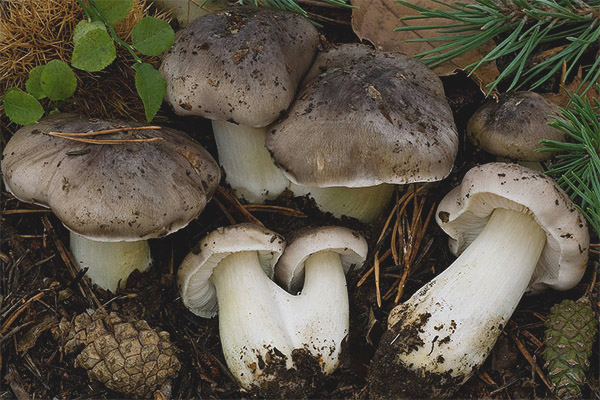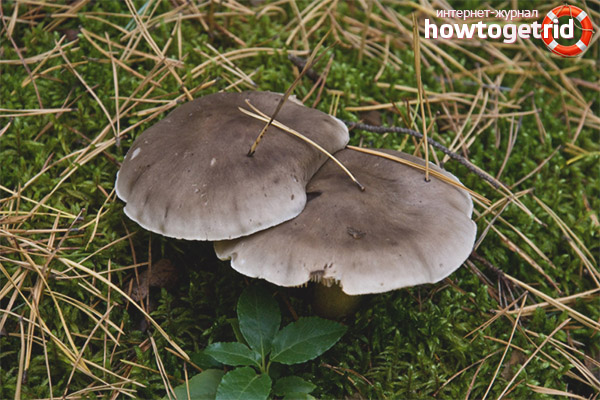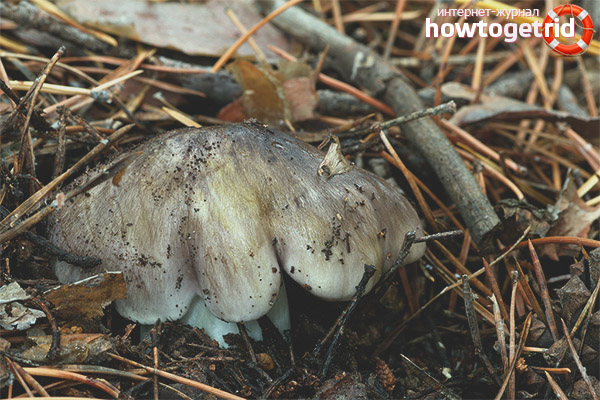The content of the article
Many mushroom pickers are skeptical of small, modest gray rows. But who knows a lot about them, he gladly puts them in a basket in order to cook then delicious original dishes, especially snacks. Gray ryadovka though the view is unassuming, but you can cook delicious dishes from it, and during processing it does not require much effort.
It is a pleasure to collect these mushrooms, because during the season it is easy enough to find them, they almost do not grow alone, so filling the containers with them is not difficult. The only danger: along with edible should not fall very similar, twins. But it is enough to study the appearance of a gray row in order not to be mistaken.
The appearance of gray ryadovki
In this gray ryadovki hat in diameter from 7 to 15 cm, quite fragile. When a hat is torn off or cut off, it makes a crisp, sonorous sound. The form at a young age is bell-shaped, but becomes fully prostrated already at a mature age.However, the older the row is, the hat becomes more and more decrepit, becomes rotten, begins to bend upwards and completely cracks.
The structure of a mature mushroom is dry and thin-fleshy, the surface is wavy, and cracked. The color is dark gray, there is always a purple or olive shade. The flesh is flat. On the entire surface visible scales - hairy and dark, radial dark stripes. Because the fungus has another name - streaky. If the weather is wet or it is raining, the hat to the touch is always mucous and becomes sticky. Therefore, leaves, needles, and pieces of soil are often glued to the mushroom.
Leg in diameter - from 2 to 2.5 cm, and height - from 4 to 15 cm, mostly straight, extended to the base. A powdery deposit sometimes appears in the upper part. Inside the leg is loose and slightly hollow, but smooth. As time passes, the foot will become completely hollow. It has a pinkish-cream color, there is also a whitish hue and vertical strokes. With the growth of the fungus, the color becomes noticeably yellow.Its pulp is fibrous, loose, always with hard veins. The foot rooted deep. The spores of the gray ryadovki without any color, smooth, ovoid-ellipsoidal in shape.
These mushrooms have such a feature: when a leg is cut, it begins to rattle over time, and then begins to break up into separate parts.
Cooking features
The pulp of the gray ones has a very pleasant sweetish taste, and the smell resembles a faint floral or powdery aroma. And those that grow under conifers, have a spicy, resinous taste. Therefore, they use mushrooms very often: they bake and fry, salt and marinate, stew and boil, add to the first dishes and salads. But nevertheless the rowing in a salty look is especially appreciated.
When the mushroom is boiled, the flesh turns gray-white, a slight chestnut flavor may appear.
In cooking, not only young specimens are valued, but also overgrown or particularly large, since such mushrooms do not lose their savory taste.
Rowing can be dried, and then it will be enough to soak for 20 minutes, and use as fresh.This type of mushrooms can be stored for a long time if they are kept in a dry place in a glass container. The cork should slightly let the air through, and every 3-4 months you should sprinkle the mushrooms with black pepper so that the food moth will not spoil them.
Like other edible mushrooms, there are also mineral substances and many types of vitamins in the row. There are also aromatic substances due to which the digestion process is improved.
Before cooking, it is advisable to remove the skin from the cap; rinse the mushroom thoroughly under running water, removing all contaminants.
Inedible is considered rowing soap. Its difference is that it has a more uniform staining, there is no fiber. But most of all it gives the smell, reminiscent of soap.
Where a good crop grows
Gray rowing can be found mainly where there is a lot of moss, fallen needles or rotted leaves. Best of all, these mushrooms grow on calcareous soils, in the forests of pine and spruce. It is noticed by mushroom pickers that most of all it is possible to assemble a row in the old pine forest. But in mixed forests, where birches and pines especially prevail, there are a lot of them. And often you can find a large family located along the path.
The main regions where the ranks grow are the European territories of Russia, Siberia, the Caucasus, the Crimea, Primorye, North America and Canada.
Fruiting begins almost at the end of the summer period - in August, and ends when the snow has already fallen, and severe frosts begin. Rowing can be collected even when other mushrooms have long been absent. The most active and massive growth is observed from mid-August, and lasts until the end of October.
Other types of ryadovka
In addition, such as gray, there are others. For example:
- Earthy. It is not so large, the cap has a pronounced fibrous-scaly, gray color. Leg more slender. It is considered almost edible.
- Different. You can recognize the color of the legs, as it is not only white, but also brown or green. The flesh has an unpleasant smell. Considered semi-edible.
- Pointed Her hat is thinner, with striped edges, the color is ash gray. The center is highlighted with a conical shape tubercle. Plate grayish color. The flesh tastes bitter and burning. She is weak-hearted.
The gray row is edible, but it was decided to rank it in the IV category in terms of consumer and nutritional indicators.She has a great similarity with the toadstool, but the rowing does not have a ring-skirt on the leg, because mushroom pickers, especially inexperienced, try not to pick these mushrooms.
Video: gray row (Tricholoma portentosum)













To send